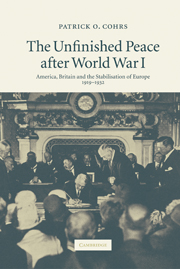Book contents
- Frontmatter
- Contents
- Acknowledgements
- List of abbreviations
- A note on the footnotes and bibliography
- Introduction
- Prologue
- 1 The wider challenges
- 2 Wilson, Lloyd George and the quest for a ‘peace to end all wars’
- 3 The ill-founded peace of 1919
- 4 The escalation of Europe's post-Versailles crisis, 1920–1923
- Part I The Anglo-American stabilisation of Europe, 1923–1924
- Part II Europe's nascent Pax Anglo-Americana, 1924–1925
- Part III The unfinished transatlantic peace order: the system of London and Locarno, 1926–1929
- 17 Sustaining stability, legitimating peaceful change
- 18 Progressive visions and limited commitments
- 19 ‘Reciprocity’?
- 20 The new European concert – and its limits
- 21 Thoiry – the failed quest for a ‘final postwar agreement’
- 22 Towards peaceful change in eastern Europe?
- 23 Achievements and constraints
- 24 No ‘new world order’
- 25 The initiation of the Young process
- 26 The last ‘grand bargain’ after World War I
- Epilogue
- Conclusion
- Map: Post-World War I Europe after the peace settlement of Versailles
- Bibliography
- Index
25 - The initiation of the Young process
The final bid to fortify the system of London and Locarno
Published online by Cambridge University Press: 21 July 2009
- Frontmatter
- Contents
- Acknowledgements
- List of abbreviations
- A note on the footnotes and bibliography
- Introduction
- Prologue
- 1 The wider challenges
- 2 Wilson, Lloyd George and the quest for a ‘peace to end all wars’
- 3 The ill-founded peace of 1919
- 4 The escalation of Europe's post-Versailles crisis, 1920–1923
- Part I The Anglo-American stabilisation of Europe, 1923–1924
- Part II Europe's nascent Pax Anglo-Americana, 1924–1925
- Part III The unfinished transatlantic peace order: the system of London and Locarno, 1926–1929
- 17 Sustaining stability, legitimating peaceful change
- 18 Progressive visions and limited commitments
- 19 ‘Reciprocity’?
- 20 The new European concert – and its limits
- 21 Thoiry – the failed quest for a ‘final postwar agreement’
- 22 Towards peaceful change in eastern Europe?
- 23 Achievements and constraints
- 24 No ‘new world order’
- 25 The initiation of the Young process
- 26 The last ‘grand bargain’ after World War I
- Epilogue
- Conclusion
- Map: Post-World War I Europe after the peace settlement of Versailles
- Bibliography
- Index
Summary
The pre-history of the Young plan and the settlement ending the Rhineland occupation, which were both finalised at the first Hague conference in August 1929, has often been portrayed as a history of decline, not only in European politics but also in transatlantic stabilisation efforts. Unavoidably, later interpretations have been coloured by what occurred so shortly thereafter: the outbreak of the Great Depression and the demise of the post-World War I international order.
With regard to European diplomacy, an ever sharper deterioration of Locarno politics has been delineated, with all sides becoming ever more uncompromising under mounting domestic pressures. And attention has been drawn to Stresemann's feeling so disappointed in 1929 that at one point, though rescinding it later, he spoke of the western powers' ‘deception’ of Germany and the failure of his own Locarno policy. Is it indeed justified to conclude that the co-operation between the Locarno powers was abandoned long before the World Economic Crisis escalated? Was Locarno diplomacy already degenerating into an ever fiercer Franco-German competition for political and financial preponderance that Britain could no longer mediate? By contrast, American policies in this critical period have been described as ‘old approaches’ in changing times – attempts to repeat the informal strategies adopted in forging the London settlement of 1924, especially in the promotion of the Young plan.
A more critical interpretation has placed US and European efforts in 1928 and 1929 in a different, already familiar continuity, that of the ‘misguided’ approaches of the mid-1920s.
- Type
- Chapter
- Information
- The Unfinished Peace after World War IAmerica, Britain and the Stabilisation of Europe, 1919–1932, pp. 477 - 530Publisher: Cambridge University PressPrint publication year: 2006



